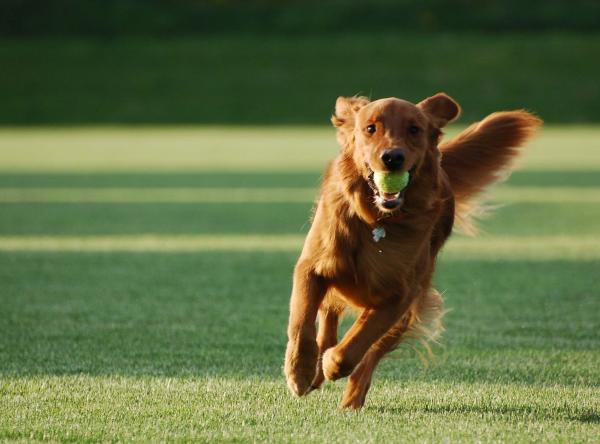My Dog Doesn't Want to Walk Outside



See files for Dogs
Most dogs will bound at the door when the slightest possibility of going for a walk presents itself. If the word ‘walk’ is mentioned or you pick up their leash, the dog often becomes very excited. This is because dogs want to explore their environment, smell new scents, mark their territory and meet new friends. If your dog refuses to walk, it means they don't want to do any of these things. While some dogs will be more excitable than others, not wanting to engage in healthy dog behaviors is a warning sign.
In this AnimalWised article we try to understand what happens when your dog doesn't want to walk outside. Whether they won't go out at all or will get scared during a walk, we find the reasons for this behavior and what we can do to change it.
Reasons why your dog does not want to walk outside
Whether our dog wants to stop walking while we are mid-walk or they don't even want to leave the house, many of the reasons will be the same. However, it is important to make the distinction since looking at the context of the dog's behavior is helpful in understanding it. It is our responsibility to ensure the dog's well-being and going out for regular walks is a major factor.
If you are still wondering why your dog refuses to go outside to walk, we look at some of the reasons why this may be so:
- Your dog has not learned to walk properly
- Walking is too stressful an activity for them
- They are afraid of stimuli in the outdoor environment (cars, people, etc.)
- Trauma
- Inappropriate restraints
- They are in physical pain
- An underlying illness is depleting their energy
- The dog is elderly
- Their routine is being interrupted
- They are easily distracted
We will explain some of the reasons a dog will not go out for a walk in further detail below. We also explain how this may be rectified, where possible.
My puppy refuses to go for a walk
If you have a puppy and are wanting to bring them out for a walk on the street there are practical requirements which need to be taken care of. They need to have started their vaccination schedule, be dewormed and have spent sufficient time with their mother and littermates. Vaccination and deworming is important as the dog is relatively vulnerable to disease and parasites in their still developmental stages.
However, staying with their mother and siblings is also very important in terms of socialization. During this period, they learn how to interact with others, where their boundaries with others stop and how to behave appropriately in different circumstances. Without learning these skills and boundaries, the puppy may have negative experiences which prohibit them from wanting to go out for a walk.
When a puppy does not want to go for a walk, it is likely because they are intimidated. They lack experience of the outside world and this means they are trepidatious. This should be less likely if they have a proper socialization process, but there are other factors which can make them uncertain about going for a walk. This is why we need to be encouraging, positive and helpful in their first steps outside. If we are not, it is possible the dog can be traumatized, making it even harder to walk them in the future.
Most puppies will want to go for a walk. If they don't, a little encouragement should go a long way. Treats can help them to see the positive in the situation, but it is also common for them to go with an older experienced dog which will be able to help show how it is done.

My adult dog doesn't want to walk outside
Unfortunately, too many adult dogs do not receive the right encouragement when they are puppies. A lack of proper socialization and education can make walking seem like an undesirable practise. Generally, it is abandoned dogs which have not received adequate care which fall into this category.
However, even adult dogs can learn to adapt and see why going for a walk is such an important part of their daily routine. Since going for a walk is a natural inclination for most dogs, we can help to appeal to this side of their nature to encourage them. Again, walking with another more experienced and friendly dog can be a great way to provide such encouragement, even when adults. The reason for this is because dogs are pack animals and they will see other dogs as an example to follow.
To prevent the dog from stopping mid-walk, we need to take small steps and build up. Don't go out for an extensive walk in an unfamiliar environment. Take them somewhere calm and quiet where they will be free from the intimidation of stranger dogs. Ensure to bring treats and use positive reinforcement to encourage their walking. Do not scold or shout at them, and do not pull on their leash to force them to walk. This will make them associate walking with a negative experience and be counterproductive to what you are trying to achieve.
Fear or stress
Dogs which do not receive the five basic freedoms of animal welfare are prone to stress. If they have experienced trauma such as abuse or abandonment by a previous owner, this can lead to fear and anxiety. However, a traumatic experience could also have happened if they were previously hit by a car or involved in a similar accident.
In these cases, we need to provide a therapeutic treatment, ideally with the help of a canine ethologist. The problem in these cases is not necessarily a lack of education, although this may be a contributing factor. Before going to a professional, you will need to look at what possible factors in their environment are causing stress. These can be varied and related to almost any element in their life.
You will help the dog to feel comfortable for going on walks if you remove the stressors in their lives or educate them to be able to cope. For example, if the dog is stressed by other dogs, we can find ways to help them get along. Our article on why a puppy and older dog aren't getting along might help.

Pain or illness
There are many health problems in dogs which present in obvious symptoms. They may have a fever, bloat in the abdomen or one of a range of issues. However, there are also some illnesses which may not present as evidently. Being in pain often falls into the latter category. Due to their high tolerance, they may not show they are in pain, but find going for a walk too difficult.
Regular veterinary checkups are important to flag any health problems the dog may have. They will be able to examine the animal and provide any tests if necessary. Another issue is that certain diseases may be weakening their immune system and lowering their energy levels. In these cases, the dog may not have the energy to go for a walk even if they wanted to.
By treating the problem, the dog should be able to return to walking as before. This is if the problem is treatable. If the issue is due to a degenerative problem where the muscles, joints and bones can no longer support the dog, they may not be able to walk in the same way. In these cases, we may be able to provide other forms of exercise such as water therapy.
Elderly dogs
If the animal is old enough to be considered a senior dog, degeneration of the body is inevitable. Some may maintain mobility up until the end, but most will find a decrease as they age. Their walks may get shorter as their body cannot keep up, even if they otherwise want to keep walking. Here are some of the problems age can cause in dogs:
- Tumors
- Deafness
- Blindness
- Anemia
- Lethargy
- Dehydration
- Obesity
- Muscle pain
- Apathy
These problems can mean a dog loses the inclination to go for a walk. Also, neurological problems are fairly common in older dogs. It is possible for a dog to become confused and disorientated, resulting in them not even understanding they are about to go on a walk. Senior dogs will need to be taken to the veterinarian for more regular checkups than younger dogs.
Encouraging an older dog to walk is possible, but you will need to change how you did it previously. Firstly, their diet should have less calories, but plenty of omega-3 fatty acids. This will stop the dog becoming obese and help their joints stay healthy, respectively. We will also need to change the pace and duration of walks.
Walking your dog correctly
Many different sources will claim dogs try to exert dominance over their guardians when we go for walks. They say things such as “don't let your dog take you for a walk, you take them”. However, many of these suggestions imply we need to dominate our dog when we walk. Some may even use choking collars or other implements to force the dog to walk beside them.
Often these types of training and manipulation can be counterproductive. Positive reinforcement is a much better way to help our dog learn how to walk properly. We need to spend time with them and reinforce learned behavior, not simply punish them. Punishing a dog often leads to the dog being confused and results in other behavioral problems, regardless if you are going on a walk.
We also need to think about how many times a day we should walk our dog. For an older or less athletic dog, this will be less. For a dog with lots of energy, it will be more. Both walking a dog too much or too little can be detrimental to their well-being.
For a walk to be carried out correctly, we need to allow our dog certain freedom to explore their environment. If they are scared, not yet trained or likely to run away for any reason, we need to keep them on a leash. However, we may be able to let them in a dog park or other area to exercise. Always bring treats to reinforce good behavior, especially when training them to urinate outside.

Strop distraction when walking your dog
The last reason a dog may not want to go outside for a walk is because they are too easily distracted. This may be due to making eye contact with other dogs, seeing something they want to chase or any one of the myriad distractions in a dog's environment.
If this is the case, it is important to remember it is normal. Dogs will want to investigate smells, sights, people and anything which piques their interest. Unless the dog is in danger, we need to ensure they are allowed to exercise a healthy interest in their world. Let them greet other dogs, let them play and stop when something interests them. We shouldn't do this all the time and we have our own agenda, but it is part of our responsibility as dog guardians to ensure they are able to do these things. If we do, they are more likely to enjoy going for a walk and we will strengthen our bond together immeasurably.
If you want to read similar articles to My Dog Doesn't Want to Walk Outside, we recommend you visit our Behavioral problems category.








